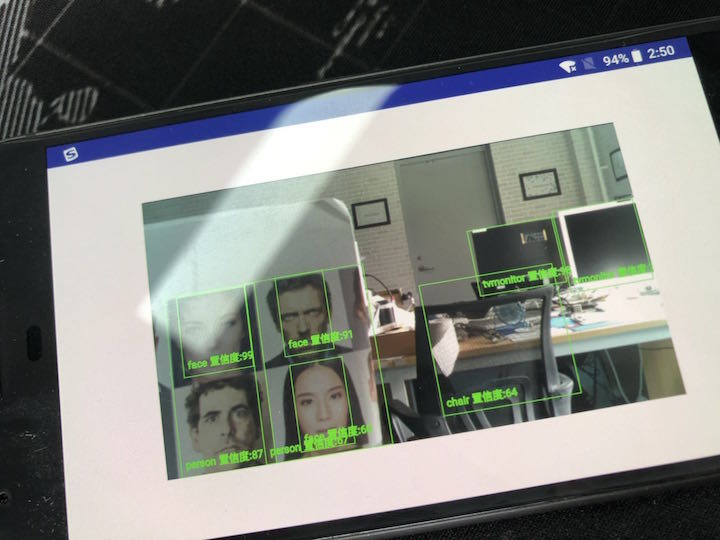多模型
本文主要给大家介绍如何在Android平台下使用多模型版本的角蜂鸟实现一个简单的多模型例子。
准备工作
- 配置环境等详情请参照Hello 2018里的快速开始,此处不具体阐述。
- 下载物体检测和人脸检测所需的俩个模型graph_object_SSD,graph_face_SSD文件,在您Android Studio中,当前module下新建assets包,将下载的模型文件复制到该目录下,该模型支持20种物体的检测。
- 因工程需要处理图像,所以使用了javacv库,可从GitHub自行下载或点击链接从示例工程中拷贝到自己工程下。
具体实现
1.实现具体步骤:
- 开启设备通信。
- 将俩个模型按顺序通过USB送入角蜂鸟里。
- 获取人脸模型对应的图像。
- 得到对应人脸模型的结果。
- 将图像进行预处理传入物体检测的模型里。
- 得到对应物体检测的结果。
2.主要代码逻辑:
//子线程中执行对应步骤代码
int status = openDevice();
int face_id = allocateGraphByAssets(mContext, "graph_face_SSD");
int object_id = allocateGraphByAssets(mContext, "graph_object_SSD");
byte[] bytes = getImage(STD, MEAN, face_id);
float[] result_face = getResult(face_id);
//...经过预处理bytes图像数据并转成float类型传给物体检测模型
loadTensor(float_tensor, float_tensor.length, object_id);
float[] result_object = getResult(object_id);
HornedSungemFrame frame = getFrameResult(image, result_face, result_object);//整合结果显示
具体代码可以参考示例工程,本文只摘取了重要代码,其中数据的处理及业务逻辑未列出
3.返回结果解析:
因本文主要用到人脸检测和物体检测俩种模型,具体的解析结果可参照模型列表的详细介绍。
int num_object = (int) object_result[0];
if (num_object > 0) {
for (int i = 0; i < num_object; i++) {
HornedSungemFrame.ObjectInfo objectInfo = new HornedSungemFrame.ObjectInfo();
int type = (int) (object_result[7 * (i + 1) + 1]);
int x1 = (int) (object_result[7 * (i + 1) + 3] * 1280);
int y1 = (int) (object_result[7 * (i + 1) + 4] * 720);
int x2 = (int) (object_result[7 * (i + 1) + 5] * 1280);
int y2 = (int) (object_result[7 * (i + 1) + 6] * 720);
int wight = x2 - x1;
int height = y2 - y1;
int percentage = (int) (object_result[7 * (i + 1) + 2] * 100);
if (type == 0) {
continue;
}
if (percentage <= 55) {
continue;
}
if (wight >= 1280 * 0.8 || height >= 720 * 0.8) {
continue;
}
if (x1 < 0 || x2 < 0 || y1 < 0 || y2 < 0 || wight < 0 || height < 0) {
continue;
}
objectInfo.setType(labels[type - 1]);
objectInfo.setRect(new Rect(x1, y1, x2, y2));
objectInfo.setScore(percentage);
objectInfos.add(objectInfo);
}
}
4.效果展示:

5.注意事项:
多模型版本处于测试阶段,如遇到问题请向我们发送电子邮件(support@hornedsungem.org)。 如有任何建议、模型需求或希望加入我们也欢迎和我们联系。